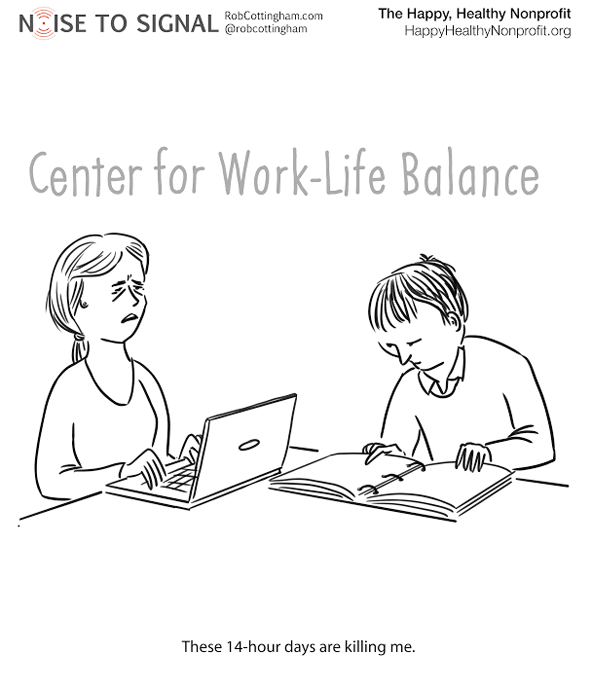Those of us who work in the nonprofit sector often distort our view of what “good work” means, because we think the nature of our work is about sacrifice. The fact that nonprofits are often financially strained—under constant pressure to do more with less—amplifies this feeling. As a result, we push through our to-do lists at the expense of taking care of ourselves. Our organizational leaders, boards, and fellow workers reinforce the idea that everything about our work is important—everything is a level 10. And together, we create a culture of overwork and overwhelm.
But being a nonprofit professional should not translate to being a martyr; it should not mean—figuratively or literally—giving up your life for a cause. We should not view dysfunctional work habits or work conditions as necessary burdens of the nonprofit world.
Instead, we should ask: Does this attitude actually lead to more social impact? Does working long hours at the expense of home life and health really help our nonprofit achieve better results?
The answer is usually “no.” Studies show that after about 50 hours of work during a week, productivity decreases. A study by Jon Percavel of Stanford University shows a drastic dip occurring after 55 hours or more of work, with output after 70 hours barely greater than output after 56—meaning 14 hours of mostly wasted work time.

Are you enjoying this article? Read more like this, plus SSIR's full archive of content, when you subscribe.
Overwork also has a marked influence on physical health. One study from the University of Texas showed an increase in health issues—including greater risk for cardiovascular disease—among workers clocking more than 45 hours per week. Another article added stroke to the health risks of working long hours. Other research shows that sleep deprivation—such as one might experience from overwork—negatively affects one’s mood, ability to focus, and access to higher-level brain function.
Research in Sweden offers additional insight. In 2015, employers at two Swedish nonprofits (a retirement home and hospital) experimented with implementing a 6-hour workday, reduced from 8. Researcher Bengt Lorentzon, who worked on the project, reported that 68 nurses who worked the shorter days took half as much sick time and were 20 percent happier than those in the control group.
Addressing Overwork
Change starts at the top. Nonprofit leaders need to actively examine how many hours they and their staff can work productively in a given week, and then begin to set appropriate boundaries—and in doing so, they need consider not just the written rules in the employee handbook, but also the unwritten and often unspoken rules. If executive directors are firing off emails at 11 o’clock at night, other staff will see that as an expectation and follow suit. Employees notice when the boss or fellow workers stay after hours, come in on weekends, or eating lunch at their desks—and they tend to emulate what they see. Making deliberate efforts not to ask staff to work during off hours or work late will have a positive impact on their mental and physical health, and reduce the likelihood of burnout.
Leaders should also encourage staff to develop individual self-care plans. The World Health Organization describes the concept of self-care as “what people do for themselves to establish and maintain health, prevent and deal with illness.” A self-care plan may include disconnecting from electronic devices, avoiding work emails during evenings and weekends, and protecting sleep time. Organizationally, it could include establishing group breaks, organizing walking meetings, ushering staff out the door at a reasonable hour, or providing ample time off for self-care activities. Here are a few examples.
1. Using vacation time. The well-known teacher-support nonprofit DonorsChoose offers 25 days a year of paid vacation and tracks its staff’s vacation use. “We work with managers to encourage their staff to take their vacation time,” explains Melanie Duppins vice president of People Operations. “We let the manager customize the message to the specific situation. For example, we might have a workalcoholic type, where the manager needs to insist that they take vacation, or maybe it is about us problem-solving with the manager to adjust the workload so the employee can take off. Or sometimes we might have people burning the midnight oil for days in row, and we talk to the manager about offering comp time.”
2. Incorporating movement into the workday. Project Kesher, which invests in leadership training and projects that empower women and girls, realized staff behavior needed to reflect the changes they were trying to make in the world. Karen Bloom, chief advancement officer, says, "If we are sitting in a staff meeting and trying to tackle a problem, I get them to stop, and I say, ‘Let's put this on our hiking meeting agenda.’ We will go in the woods with our list and brainstorm ideas for campaigns or programs. We have found that a one-hour walking brainstorm yields more creative ideas than if we sit in our chairs in a stuffy conference room."
3. Developing self-care plans. The employee handbook at New York City’s Crisis Text Line explains the link between self-care and productivity, encourages staff to create their own plans, and provides support and resources, such as offering sabbaticals to staff members who have been at their respective organizations for two years.
A healthy, high-performing nonprofit starts with nonprofit leaders who empower their staff to thrive in life and at work. Culture shifts toward self-care and away from burnout start at the top and should be strategic priorities—not just of nonprofit leaders, but also organization boards and funders.
This story has been updated at the authors' request.
Support SSIR’s coverage of cross-sector solutions to global challenges.
Help us further the reach of innovative ideas. Donate today.
Read more stories by Aliza Sherman & Beth Kanter.

